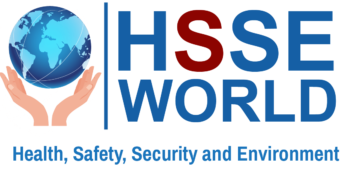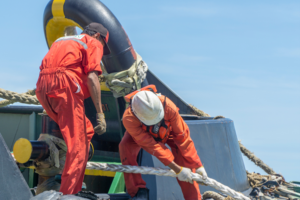Inspecting Fall Protection Equipment Forms
6 min readSuppose you’re in the lifting or rigging industry, construction, or any type of general industry where your employees are working at height. In that case, you’re required to have fall protection equipment forms for inspection and working heights of as little as 4-8 feet. In May 2017, OSHA made changes to fall protection standards requiring businesses to provide training on fall protection to employees who are working at height. Not only do you need to provide fall protection training for your workers, but you also have to have an inspection program in place to assess the condition of your gear.
In this article, we provide you with the Fall Protection Equipment inspection forms :
- Anchorage Connectors – Inspection Form
- Carabiner- Inspection Form
- Harness-Inspection Form
- Lanyard- Inspection Form
- SRL-Inspection Form
- Removable Concrete Anchor

Our goal is to help you understand that safety is an investment in keeping your people safe. The cost of keeping your fall protection system in compliance should not be considered an expense but should be looked at as an investment that, over time, helps keep your employees safe.
5 Steps for inspecting fall protection equipment
Years ago fall protection equipment was heavy and uncomfortable. Buckles and D-rings were clumsy, bulky forgings. Harness webbing was stiff and abrasive. No wonder workers avoided wearing them, even when they understood the risks. Manufacturers began to take notice. Changes appeared; slowly at first but now more rapidly. Our wake-up call came tragically.
We introduced a tower worker’s harness that met all the OSHA and ANSI requirements. Unfortunately, we were totally oblivious to the comfort level we were offering. Successfully passing drop tests, stress requirements, and the like was not enough.
A young worker, in his early twenties, found the leg straps extremely uncomfortable. He had his own creative solution. With a little duct tape, he was able to get those straps “out of his way.” He fell, slipped out of the harness, and plunged to his death. His widow and two small children took no comfort in the fact that he had been issued fully compliant fall protection equipment. As a manufacturer, we were not legally responsible, but we knew we had not provided all that was needed. We also realized this tragic scene had replayed itself multiple times across our industry.
Today, along with all reputable manufacturers of fall protection devices, we are in ongoing discussions with our end-users. We listen when they express a concern or a need. Then we take what we’ve heard to our engineers and product development team to make certain our equipment is user-friendly as well as OSHA compliant. Today webbing is soft and pliable, stretch fabrics are available. Hardware is lightweight; closure designs offer simple and quick operation.
Appearance and style have become extremely important in the safety equipment industry. Fabric and color influence a worker’s perception of a harness and his attitude toward wearing it. In short, if it looks good and fits comfortably, a worker will put it on. That’s step one. After proper training, he is ready for the job site. Training includes equipment maintenance and inspection.
how-to-inspect-your-fall-harness-when-working-alone
Inspection instructions
A fall protection system must be inspected regularly, meaning before each use. This is not just a cursory “once over”. If it fails to pass inspection, immediately remove from service the faulty component or components. Follow these inspection instructions:
First, look for the equipment’s date of manufacture, indicated on the product label. Always check your manufacturer’s instructions. If the equipment meets the manufacturer’s instructions, begin to examine each component. Check for wear and deterioration. Look for evidence of impact loading. Visually inspect for loose threads, pulled rivets, burns, cuts, abrasions, or other evidence of chemical or physical deterioration that may have weakened the material or assembly.
Inspect all hardware including, but not limited to, hooks, buckles, and D-rings. Look for any cracks or malfunctions. Immediately remove from service all components that fail.
1. Stitching and webbing.
Check stitching for broken, burned, cut, or pulled stitches. Broken strands of webbing appear as tufts on the webbing surface. To visually check for damage caused by corrosives, heat, chemicals and other conditions, hold the connecting device with your hands six to eight inches apart. Bend the webbing in an inverted “U” to cause surface tension and expose problem areas. Inspect the entire length. For deceleration units, check the stitching for broken, burned, cut or pulled stitches. Check the breakaway jacket for cuts, broken stitches, tears, stretch marks or other evidence of impact load.
2. Broken strands
Inspect rope lanyards for broken strands by twisting the rope slightly to undo the braiding. Inspect the entire lanyard in this manner. Discard lanyards with broken strands.
NOTE: Twisted rope, such as nylon filament and polypus rope used in lanyards, is subject to a condition known as “hockling,” similar to the condition often seen in a telephone handset cord. Causes may be a repetitive twisting movement such as normal hand rotation in hooking and unhooking, a lanyard dangling freely, or using the lanyard to suspend equipment. Preventive measures include: 1) Inspection and smoothing out after each use, 2) Storing neatly, and 3) Never using a lanyard for towing or hoisting. Some hockling is normal and is not a reason to discard a lanyard.
3. Inspect all hooks, D-rings, and all other metal parts.
Check hardware for sharp edges and cracks. Rollers must not be distorted and should roll freely. Check all parts, especially corners and attachment points, for wear and cracks.
4. Destroy and replace all worn or damaged equipment.
Never use it! Using this equipment may cause injury or death.
5. Remember, the inspector is the most important part of any inspection procedure.
He or she must be well-trained and understand what he/she is looking for. Our objective is not merely compliance. We must do our part to provide a safe work environment.
fall-protection-lanyards-and-srls-inspection-criteria
Download the Fall Protection Equipment Forms
These Forms are not all-inclusive. You may wish to add to them or delete portions that do not apply to your workplace. Carefully consider each item as you come to it and then make your decision. Do not spend time with items that have no application to your workplace.
Fall Protection Forms
- SRL Inspection Form ( DOWNLOAD PDF) And ( DOWNLOAD DOC )
- Lanyard Inspection Form ( DOWNLOAD PDF )And ( DOWNLOAD DOC )
- Harness Inspection Form ( DOWNLOAD PDF )And ( DOWNLOAD DOC )
- Carabiner Inspection Form ( DOWNLOAD PDF )And ( DOWNLOAD DOC )
- Anchorage Connector Inspection Form ( DOWNLOAD PDF )And ( DOWNLOAD DOC )
For Many Safety Resources visit Safetybagresource
More Forms
- Downloadable Kitchen Safety Inspection Checklist for Restaurants
- Mastering LOTO: Protecting Workers with Energy Isolation and Isolation Confirmation Certificates
- Flammable and Combustible Storage Checklist Free Download
- Secure Your Lifts:Guidelines for Safe Lifting Operations Free Planning Tool
- Sample of Accident Prevention Program ( APP) Template for General Industry Free Download
- Free ISO 14001:2015 Environmental Management System Audit Checklist Download
- Guides for Walking and Working Surfaces Safety Program
- Workshop Safety Guideline and free Posters
- Free Ergonomics Checklist for General Industry
- Work Area Safety Checklist
- Machine Safety and 43-Equipment Inspection Checklists
- Scaffold Safety self Audit and checklist
- Hot Work Controls and its Permit to work Form
- Safety Observation Report Template
- Forklift Operator’s Daily Checklist and safety Tips
- Inspecting Fall Protection Equipment Forms
- Templates: HSE Incentives and rewards
- 35 Inspection forms for Rig Check
- Chemical Risk Assessment form
- 22-Safety Inspection Checklists
- Safety Task Assessment Form
- Suspended Scaffold Pre-Operation Inspection Checklist
- Photo of the day: New worker Orientation & Safety Orientation checklist
- Grating-Decking-Floor- handrail-Removal Form
- Electrical Inspection Checklists
- E-Books: Fire Safety Logbook templates
- General Safety Guidelines and Employee Acknowledgment form
- Annual Internal Audit Form
- Mobile Scaffold Inspection checklist
- Simultaneous Operation (SIMOPS) checklist
- Temporary Construction Facilities (TCF) Inspection checklist
- HIRA, HSE Hazards & Effects Management Process (HEMP) & Risk Register Template
- Hazard Identification Plan (HIP) Template
- Ladder Inspection Form
- Free Pre-Startup Safety Review Checklist (PSSR)
- Hazard Identification Checklist
- Workplace Housekeeping Checklist
- ISO 45001:2018 READINESS CHECKLIST
- Lifting Plan Audit Checklist
- Job Safety Analysis (JSA) Forms What’s Right and Wrong?
- Electrical Isolation Permit to Work forms and checklist
- Canteen Inspection Checklist
- Work at Height Checklist
- Health Safety at Work Improvement Action Plan
- Fire Pump Daily Inspection Checklist
- Construction Site Traffic Management Plan (CSTMP) Guidance
- Safety Templates: COVID-19 Safety Plan
- Workplace Safety Inspections Forms
- Lock Removal Form
- Templates: Management of Change NEW Modified Equipment Safety Checklist
- Lifeline & Harness Inspection Guide checklist
- Contractor Pre-qualification Questionnaire Checklist
- Fall safety at construction checklist
- Construction safety Inspection checklist
- Equipment Safe Operating Procedures- SOP 61 checklist
- Permit to Work (PTW ) AUDIT CHECKLIST
- Hygiene and Sanitation Inspection Checklist



